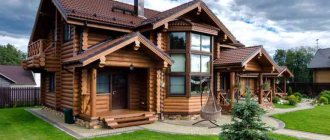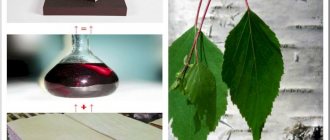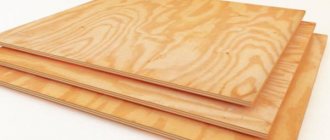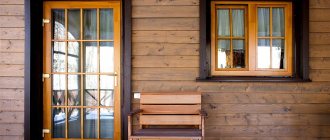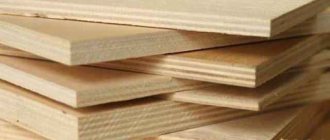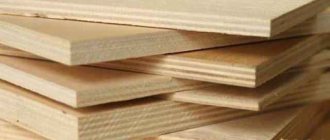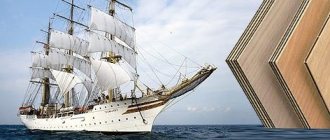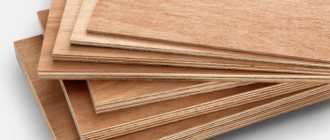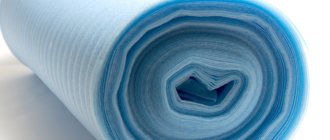Bakelite plywood is also called bakelite or marine plywood. Durable material has a multi-layer structure. The main raw material for its production is birch wood. The layers or veneer of this tree are firmly bonded together with resins and subsequent heat treatment. Marine plywood is distinguished by such properties as reliability, high strength and wear resistance.
Bakelite plywood acquires special properties as a result of treatment with bakelite varnish, from which it gets its name. Marine plywood can withstand temperatures from +50 to -50 degrees, while it is not susceptible to mold or mildew. It can also be used even in tropical climates with high humidity levels. Moreover, its useful life is 15 years or more. This type of plywood will be described in detail below. The article talks in detail about the material and its areas of application, adds a couple of useful videos on the topic, and also offers the reader interesting material for downloading.
What is bakelite plywood?
Properties and technical specifications
You can distinguish bakelized plywood from regular plywood by color: it is slightly darker, with a red-brown tint. Standard material parameters:
- Dimensions - 5700x1250 mm, 2850x1250, 2500x1250 mm, 2440x1220 mm.
- Thickness - 7, 10, 12, 15, 18, 21, 24, 27 mm.
- Material density - 1200 kg/m3.
- Tensile strength along the fibers is 73.5 MPa.
- Static bending strength – 78.5 MPa.
- Standard parameters of laminated plywood are 1220x2440 mm, 1250x2500 mm, 1500x3000 mm.
- Sheet thickness: 4, 6, 9, 12, 15, 18, 21, 24, 27, 30 mm.
- Width of veneer strips: not less than 200 mm. For the FBS brand – at least 400 mm.
One of the main advantages of bakelite plywood is its high strength, comparable to the strength of high-quality alloy steel. In addition, this material has other positive properties.
Interesting read: what is boxwood?
Properties of bakelite plywood.
These include:
- High moisture resistance.
- Durability.
- Not subject to delamination during operation.
- Fire resistance. When the temperature is significantly exceeded (up to 350 C⁰), it becomes charred and does not support combustion. At the same time, the smoke generated during the smoldering process does not have a pronounced suffocating or toxic effect.
- Good resistance to bacteriological and chemical influences (not afraid of kerosene, sea water, weak acids, alkalis, gasoline, not damaged by fungus and mold).
- Environmental Safety.
That is, rating this material on a five-point scale, you can assign it “fives” in the areas of quality, reliability and practicality. In addition, it deserves an “excellent” rating for its simplicity and ease of use. The only thing that can slightly reduce points when evaluating bakelite plywood is its high cost.
What is Marine Plywood.
Foundation Block Technology
| The production of FBS (foundation blocks) is a very profitable investment of capital, especially for those companies that have concrete production or have their own vehicles. The technology is that in 1 hour you can make 5 blocks, and in a day 40 blocks from 1 mold. |
|
|
Production infrastructure requirements
| Production area | 100-120 sq.m |
| Area of adjacent open space | 200-500 sq.m |
| Temperature | standard, +1-(+25) C |
| Lighting type | general, LED fluorescent lamps |
| Electrical communications | ~220 V, ~380 V, 10 kW |
| Technical water supply | Not required |
| Exhaust ventilation | Not required |
| Sewage drain | Not required |
| Heating | Not required (for production premises only) |
Main equipment, fixtures and fittings
| No. | Name of equipment | Qty | Total cost of equipment for the production of SSS, USD. e. |
| 1 | Shape 30*240*60 | 1 PC. | 4 500 |
| 2 | Shape 40*240*60 | 1 PC. | 5 000 |
| Total: | 9 500 |
The production time for molds is 45 days.
Workshop staff
| Profession | Quantity |
| Moulder | 2 people |
| Total | 2 people |
| Dependence of income on investing financial resources in the production of polymer-cement artificial stone | |
| Sale of technology (documentation set, training) | 500 USD |
| Total | 10,000 USD |
Dissolver production time is 1 month. While you are preparing the production premises for installing equipment for block production, we will manufacture all the equipment.
Production costs (fixed) per month
| No. | Cost item | Amount, c.u. |
| 1 | Rent of production premises | 400 |
| 2 | Depreciation of capital equipment | 50 |
| 3 | Employees' salaries | 1000 |
| 4 | 400 | |
| 5 | Electricity | 200 |
| Total: | 2050 | |
| Production costs per day (22 working days) (With an annual depreciation period.) | 93 |
Total production cost per day
The raw material cost of 1 block 30*240*60 is 16 USD. The production capacity of the equipment is 80 blocks per shift. Thus, the raw material cost per day is 1280 USD. e. + Production costs 93 USD. e. Total, total cost without taxes is 1373 USD.
The average market price of 1 block (30*240*60) is 35 USD. those. 35*80 – 2800 USD
Economic efficiency
When you open the production of foundation blocks, your profit is: Total cost per month 1373 * 22 = 30,200 USD. Sales price of the product is 2800 * 22 = 61,600 USD.
Profit for the month 61600 – 30200 = 31400 USD (excluding taxes)
Economic justification for opening production based on our own experience
Of course, in the first month your volumes will not exceed 50%, analyzing from your own experience.
At the same time, the competition of materials significantly exceeded the consumption of imported materials in relation to our products, but time passed and our products established themselves at low prices, since this is not our main business, due to discounts, production time of 1-2 days, written guarantees. If you have a demand for this, then it is possible to produce 120 blocks per shift.
This business brings in a lot of money because the investment is minimal. Our company brought technology from the West, and now you don’t need many forms (large capital investments), now you can do it quickly, efficiently and inexpensively.
Thus, even if you sell FBS at first, your profit will cover all your costs and you will receive a profit in the amount of 15,000-31,000 USD, and if you take away taxes, the net profit will be approximately from 11,000 to 27,000 USD.
What is bakelite plywood made of?
What are they made from this material? Even during the Great Patriotic War, hulls for fighter aircraft were made from bakelite plywood. Today it is used by construction companies in the manufacture of formwork panels for monolithic buildings, for the arrangement of floors, partitions, roofs, decks, ceilings, internal cladding, and for the manufacture of exhibition stands. It is used to line the sides of ships and trucks. It is used for:
- shipbuilding;
- car production;
- construction and repair work.
Expert commentary
Ostakhov Alexey Mikhailovich
Practical experience, higher construction education. I talk about repairs and construction in clear language
Ask a Question
Plywood sheets are used in hydraulic engineering in the construction of equipment (hydraulic shut-off) such as sluices and hydraulic locks. Plywood formwork is considered durable and cannot be deformed. However, it is an expensive material, so plywood sheets are used more in professional construction and industrial production.
Advantages of bakelite plywood:
- wear resistance;
- it is not sensitive to temperature changes;
- does not ignite;
- does not contain any harmful substances, does not emit toxins.
Features of the manufacture of multilayer boards are that during the production process the inner and outer layers are coated with resin. It is made from birch veneer according to GOST standards. During its production, veneer layers are impregnated with high-quality resin, and then glued together at a temperature of 360 degrees under high pressure. The result is a durable, strong and heavy material.
Laminated plywood.
Its sheets are hard, thanks to which it holds its shape perfectly even under heavy weight. The material is resistant to water, alkalis, acids, and high temperatures. Even at a temperature of 350ᵒC, the multilayer building material does not ignite.
Expensive production technology makes the raw material unprofitable for cladding a house or making simple formwork, but its excellent performance properties have long been appreciated in the construction and chemical industries. During operation, plywood sheets do not become moldy, it does not rot, and fungus never appears on the surface of the boards.
Application area
Thanks to the properties that we have become acquainted with above, this material has found wide application not only in construction, but also in various types of industry.
In particular, it is used for the following purposes:
- in shipbuilding for the manufacture of decks of yachts, ships and boats;
- in aircraft and automotive manufacturing;
- when arranging formwork and floors with your own hands;
- in the furniture industry;
- for interior decoration;
- for roofing and exterior finishing of buildings.
This material is also used for the manufacture of sports equipment, products for children and much more.
In the photo - plywood sheets of the FBS brand
Advantages of bakelite plywood
Bakelized plywood FBS and FBV has the following advantages over competitive materials of this type:
- Wear resistance. Plywood has a long service life, which is achieved due to the specific properties of the impregnation, which does not evaporate for an extremely long time.
- Heat resistance/fire resistance. No wonder the tank. plywood is used even in tropical conditions and in high-temperature industries - this material perfectly withstands temperatures of +50 degrees Celsius, does not catch fire or smolder.
- Frost resistance. As you know, any material cannot be used for a long time in conditions of extreme cold - such as in Siberia or other frosty areas of the Earth. However, bakelite plywood is not afraid of temperatures of -50 degrees Celsius, while functioning perfectly.
- Moisture resistance. Bakelized plywood 18 mm and no longer loses its strength and does not collapse under the influence of moisture. Add to this resistance to rot and insects/fungi and you get an ideal (though quite expensive) option for roof and attic floors.
- Chemical resistance influences. Tank. plywood is not afraid of aggressive environments - gasoline, kerosene, other fuels and lubricants, acids, alkalis, sea water do not harm the material, so it can be used in any production.
- Resistance to the influence of fauna (no bark beetles, mold or mice can damage tank plywood). Of course, a plywood tank also has its drawbacks. There are only a few of them:
- Heaviness. Due to its impregnation, the specific gravity of the tank. plywood is slightly heavier than standard material, even if birch wood is used.
- Environmental unsafety. Due to the fact that FBS plywood is extensively treated with carcinogenic materials, it is not recommended for use indoors. However, this does not apply to FBV plywood - an environmentally friendly material, which, however, has lower performance in other parameters.
- Expensive. Of course, thanks to such impressive parameters, the tank. plywood and costs accordingly. However, we can say with certainty that this material will earn every penny invested with its characteristics and features.
As you can see, bakelite plywood, the technical characteristics of which are an order of magnitude superior to other materials, is an excellent product with an extremely wide range of applications.
Types of Bakelite Plywood
Like any other material, tank. plywood is divided into grades. FBS and FBV plywood are the two main types of material, which in turn are divided into subtypes. Let's take a closer look at them.
- Bakelized plywood grade FBS. A type of material with the most developed protection against all known physical and chemical aggressive manifestations. In addition to bakelite itself, many of its subspecies are also processed with alcohol-soluble resins. It is divided into the following types:
- FBS. The most expensive type of brand, which has all possible protection options. It has high inflammability, moisture resistance and strength. Impregnation is carried out not only from the inside of the plywood, but also from the outside. The impregnation procedure itself implies the fact that each sheet of veneer is completely immersed in a vessel with glue and remains there for a long time.
- FBS 1. A less protected option that has a reduced level of impregnation. The outer and inner layers of veneer are simply coated with a solution, and not dipped, as with FBS.
- FBS A. The most dangerous version of the material for humans. It is coated on the outside and inside with a very concentrated solution, which makes it possible to use plywood exclusively in the field of mechanical engineering to cover internal structures;
- FBS 1-A. The cheapest material option, which is in constant demand. It is coated with alcohol-soluble resin, therefore it has positive environmental safety indicators, but is most susceptible to the influence of weather conditions.
- Bakelized plywood grade FBV. This material is created on the basis of water-soluble resins, therefore it has good environmental safety indicators. This means that FBV plywood is quite suitable for treating indoor surfaces. Divided into the following:
- FBV. Just as with the FBS option, FBV plywood is completely impregnated with water-soluble resin, dipping the veneer into vats of the substance. This material is used exclusively indoors, since its level of protection will not allow it to withstand the influence of external conditions.
- FBV 1. This material is treated with phenol-formaldehyde water-soluble resin, so it is not advisable to lay it inside residential buildings. It is best suited for processing passage rooms - corridors, extensions and dressing rooms, since the veneer is simply coated with resin inside and out.
READ What is moisture-resistant plywood and where is it used?
Table of the main properties of bakelite plywood.
Production of bakelite plywood.
Like other plywood, bakelite material can be sanded or unsanded. In this case, the following letters are added to the brand designations:
- NS – unpolished material;
- Ш1 – front side is polished;
- Ш2 – polished on both sides.
Material on the topic: Why wood boards are finished with veneer.
Also, when purchasing a plywood tank, pay attention to the material’s compliance with all GOST standards. It so happens that in Russia there are two dozen factories that produce bakelite plywood.
However, finding this material is very difficult because its prevalence is low. But there are more than enough fakes of varying quality. Therefore, you should not buy this plywood from an unverified place, or you should make every effort to check its “pure” origin.
Folded sheets of plywood.
What does the price depend on?
The price of bakelized plywood, due to its exceptional qualities, is much higher than regular plywood, but, as professionals advise, it is better to use it.
Manufacturers of bakelite plywood in Russia, when setting prices, primarily focus on:
- Brand (since different types of resins are used);
- Reliability of the veneer used in production and its processing;
- Plywood sheet thickness and format: the larger, the more expensive.
But, you can always find the optimal price-quality ratio, for example, buying a thicker sheet will cost less than two thin ones.
Plywood classification: outer layer
There are five varieties of plywood - the classification is based on the appearance of the outer layers of the material. Each side of the plywood can have its own grade. The full name of the variety is indicated by two designations (through a fraction). The first gives an understanding of what material is used to make the front side of the plywood, the second - the back side. Let us list the possible designations of layers.
- E - complete absence of visible defects, however, slight deviations in the structure of the wood may be allowed. Not allowed: dark eyes, falling out and healthy knots (partially fused or unfused), holes from knots, wormholes, brown veins. Class E plywood can be varnished. It is used for facing work.
- I - minimum of visible defects. Class I plywood may have intergrown or partially intergrown falling knots, holes from them or wormholes, but their diameter should not exceed 6 mm, and the number should not exceed three pieces per 1 m2. In addition, the presence of no more than five fused healthy knots per 1 m2 (diameter within 15 mm) and a small number of brown veins is allowed. Plywood of this class can be varnished; it is usually the raw material for the production of laminated plywood.
- II - plywood of this class may have more pronounced defects. Including fused or partially fused falling knots, holes from them or wormholes, but their diameter should not exceed 6 mm, and the number should not exceed six pieces per 1 m2, as well as up to ten healthy fused knots, the diameter of which does not exceed 25 mm. Open defects and knots are sealed with veneer inserts, and subsequently the plywood is covered with finishing materials and paint.
- III - this type of plywood may have even more defects. Thus, fused or partially fused falling knots, holes from them or wormholes are allowed, but their diameter should not exceed 6 mm, and the number should not exceed ten pieces per 1 m2. There can be an unlimited number of healthy fused knots. This material is used to create structures that are hidden from external view.
- IV - any manufacturing defects are acceptable. There is only one limitation: the diameter of knots, holes from them and wormholes should not exceed 40 mm. This plywood is used for the production of packaging, during roofing work, installation of walls and floors.
Bakelite plywood in construction.
Plywood classification: dimensions
Plywood can be in regular format (square and rectangle) or large format (one side is more than 1830 mm). There is also plywood of non-standard sizes. Smaller material can be obtained after trimming all wood defects. It is also possible to produce larger sizes of plywood, but such materials are usually produced to order under a separate contract.
Pros and cons of bakelite plywood
Increased strength of slabs
Longer service life
High resistance to aggressive environments
Resistant to mechanical wear
Widely used in interior decoration, shipbuilding, structural construction
Relatively high price
Contains and releases small amounts of formaldehyde
Heavy weight
Reduced flexural strength
Types of plywood
There are seven main types of plywood:
- FK plywood is a moisture-resistant type; urea resin is used for gluing veneer sheets. This plywood is intended for indoor use.
- FKM plywood – has increased water resistance and is made on the basis of melamine resins. This type of plywood is unique, since environmentally friendly melamine resins are used for its production. Due to its environmental characteristics, plywood is used in furniture production. In addition, FKM plywood is used for interior finishing work.
- FSF plywood - veneer sheets are glued together using phenolic resin. This type of plywood also has increased water resistance. Typically used for exterior finishing work.
- Laminated plywood is based on FSF plywood, which is covered on both sides with a special film. Laminated plywood is used for the manufacture of formwork. This type can be used repeatedly.
- Bakelized plywood – bakelite resin is used to glue veneer sheets together. This type of plywood is used in aggressive climates, sea water, aggressive environments, and sometimes for monolithic work.
- Marine plywood is similar to bakelized plywood, but less durable. Made from foreign wood species.
- Flexible plywood is a foreign option. A distinctive feature is the ability to bend well in the transverse and longitudinal directions.
READ What is laminated chipboard and where is this material used?
Depending on the type of mechanical surface treatment, plywood can be of three types: unsanded, sanded on both sides or one side.
Use for formwork.
Plywood is a product made from various types of wood. It could be: birch, aspen, pine needles, poplar. Combined plywood is called plywood, which includes several types of wood material.
Question to the expert
What material is bakelite plywood made from?
Birch plywood is a very durable type. This is determined by the high physical and chemical properties of birch plus a multilayer structure. Coniferous plywood is made from pine, which provides strength at a relatively low weight. This type is successfully used in the construction of houses. The quality of plywood depends on a number of indicators.
The main one is the emission class of free formaldehyde (E1-E2). The quality of the product is also ensured by such indicators as: tensile strength when chipping, tensile strength of samples, static bending, structure, color of knots, presence of defects, moisture content. The grade of plywood is determined by the number of knots per 1 square meter. Plywood can be of four grades.
Construction and bakelite plywood
The most popular type is construction plywood sheets, which are made from pine and larch. The thickness of such a plate is 2-4 mm. There are combined options, for the production of which two different types of wood are used. Products based on the use of coniferous veneer are divided into 6 types. They are used for both external and internal construction work.
Interesting read: balsam fir wood.
Combined plywood is available in a wide range. The length of such sheets can be almost 2.5 m, the width can be 1.20 m. The thickness of plywood sheets ranges from 0.8 to 3 cm. There is also plywood, for the production of which alder is used. This representative of coniferous forests is used much less frequently, but is of higher quality.
Moisture-resistant, durable bakelite plywood.
Bakelite plywood consists of birch veneer and phenol-formaldehyde resin is used as impregnation. The outer layer of such a product can be impregnated with an alcohol-soluble composition. This type of plywood is characterized by high strength and can withstand heavy loads, so its use is not limited only to interior work, it is used in shipbuilding, construction, aircraft manufacturing, etc. the thickness of such a product is 0.5-1.8 cm, length 7.70-1 .5 m, width – 1.55-1.2 m.
Plywood for cladding has peeled veneer in its structure. In this case, one side or both have a polished surface, which makes it possible to use it for finishing work. The glue can be based on phenol-formaldehyde or urea-formaldehyde. Cladding plywood is available in two grades.
For interior and exterior wall decoration, bakelite plywood is attached to pre-plastered concrete bases using various mastics, for example, definol. To ensure longer service life of plywood sheets, they are coated with special varnishes or waterproof impregnations. Before starting this procedure, all existing joints are covered with thin beams, and uneven areas and cracks are primed. This type of treatment helps protect the wood product, as well as the walls underneath it.
FAQ
What temperatures can bakelite plywood withstand?
Can be used at temperatures from -50 to +50 degrees.
What is the service life of bakelite plywood?
Service life is up to 15 years.
Which bakelite plywood is considered defective?
Bakelite plywood with uncoated and unimpregnated areas, bubbles, under-pressing, and delamination is considered defective.
Historical prologue
The invention itself belongs to the domestic chemist and inventor Yakov Davidovich Avrasin, who in the 40s of the 20th century, using formaldehyde resins, gave plywood the qualities that made it possible to construct airplanes from this material. The need for the invention was caused by an acute shortage of light aircraft alloys.
The idea was picked up and implemented by Vladimir Petrovich Gorbunov, a famous domestic aircraft manufacturer.
The process itself went as follows:
- Birch or pine veneer, after manufacture, was impregnated with either cresol-formaldehyde or phenol-formaldehyde resins;
- After this, thermal pressing was carried out using high pressure (270 degrees Celsius, a pressure of 6 atmospheres);
- The result: at the end we have a strong puff pastry, comparable in strength to steel, somewhat heavier than wood, but also stronger.
Interesting to know! At one time there were scientific disputes about the separation of this material into an independent group of materials; even a separate name was invented for it - delta wood. However, in essence, bakelite “layer cake” still remained plywood, although it was actively used in aircraft construction, especially in Japan. Legends about plywood planes of kamikaze pilots are still alive.
From history to modern times
Currently, aviation has reserved this material only for the so-called small aviation. The focus of application has shifted from aircraft construction to shipbuilding. And although it is clear that no one will make the hulls of ocean liners from this material, baked plywood is quite suitable for boats, boats, and yachts.
A few words about technology:
- During numerous experiments, it was noticed that birch veneer is much superior to coniferous veneer in its ability to be impregnated with special impregnations (in this case, bakelite varnish);
For your information! The varnishes were incorporated into the wood so tightly that they made the veneer structure almost uniform, which was the reason for declaring delta wood.
- In all other respects, the technology has remained virtually unchanged. After impregnation, perpendicularly located fibers of adjacent layers are placed in a chamber where the material is pressed under conditions of elevated temperature and pressure.
Regarding properties
Like every material, plywood has its own standards, which determine the quality of the product and the possibility of its use in modern industry. All features of bakelite puff can be found in GOST 11539 83 for bakelite plywood.
Let's talk about this in a little more detail:
- Water resistance. This property is achieved through the same special impregnations or varnishes. The material is not afraid of either fresh or salt water;
Note! The ability of the material to withstand the salts of sea water, as well as some acids, distinguished it among the marine ones; there is another popular name for this puff - “marine plywood”.
- Fire resistance. Products made from such material do not burn. At a temperature of 350 degrees Celsius, plywood begins to char and does not support active combustion. The smoke that is released during this process does not have a pronounced suffocating effect;
- Not susceptible to rot or fungus. In principle, this says it all, plywood does not need additional protection or impregnation, and there is no need for lamination;
- Heat resistance. The material feels great with sudden temperature changes in the range of 100 degrees Celsius. Products made from it can withstand sudden temperature changes from -50 to +50 degrees Celsius;
- Durability. Due to the different arrangement of veneer fibers, the material has good strength and is able to withstand significant loads in both direct and lateral directions.
